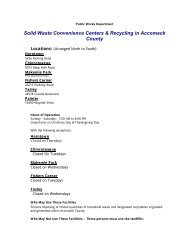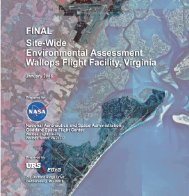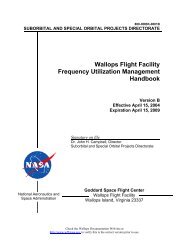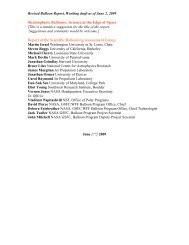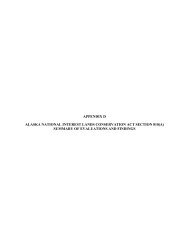Alternative Energy Draft EA - NASA Visitor Center at Wallops Flight ...
Alternative Energy Draft EA - NASA Visitor Center at Wallops Flight ...
Alternative Energy Draft EA - NASA Visitor Center at Wallops Flight ...
You also want an ePaper? Increase the reach of your titles
YUMPU automatically turns print PDFs into web optimized ePapers that Google loves.
Proposed Action and <strong>Altern<strong>at</strong>ive</strong>s<br />
2.1.1.2 Potential Loc<strong>at</strong>ions for Wind Turbines <strong>at</strong> <strong>Wallops</strong> <strong>Flight</strong> Facility<br />
Utility-Scale Turbines<br />
Based on wind studies and comp<strong>at</strong>ibility with mission-rel<strong>at</strong>ed activities (JMU, 2005; Iberdrola,<br />
2009), <strong>Wallops</strong> Island was identified as the preferred loc<strong>at</strong>ion for siting a wind turbine to<br />
maximize the wind resource available <strong>at</strong> WFF.<br />
Other loc<strong>at</strong>ions <strong>at</strong> WFF were considered for construction of one or two wind turbines. Wind<br />
turbines have the potential to interfere with WFF’s active airfields and tracking/telemetry<br />
systems; therefore, the area available for their construction is extremely limited.<br />
The entire <strong>Wallops</strong> Main Base was dismissed due to height restrictions to maintain Federal<br />
Avi<strong>at</strong>ion Administr<strong>at</strong>ion (FAA) Part 77 airfield obstruction requirements. The available loc<strong>at</strong>ions<br />
for turbine(s) install<strong>at</strong>ion <strong>at</strong> the Main Base would result in a viol<strong>at</strong>ion of the FAA height<br />
restrictions of objects within a specified distance of a public or military runway; therefore siting<br />
of the turbines <strong>at</strong> the Main Base was dismissed.<br />
The entire <strong>Wallops</strong> Mainland was dismissed due to impacts on the performance of radar<br />
frequency systems (QinetiQ Inc., 2004). In addition, <strong>NASA</strong> undertook a rigorous internal siting<br />
exercise to identify a loc<strong>at</strong>ion for the proposed wind turbines th<strong>at</strong> would not interfere with<br />
existing or planned mission activities on <strong>Wallops</strong> Island. This exercise was led by the WFF<br />
Facility Director with assistance from the Radio Frequency Spectrum Manager, Facilities<br />
Management Branch, and Environmental Office. The team evalu<strong>at</strong>ed all lines of sight for the<br />
<strong>NASA</strong> telemetry systems and U.S. Navy radar viewsheds. On <strong>Wallops</strong> Island, all areas north and<br />
east of the proposed wind turbine site were dismissed due to impacts on U.S. Navy radar systems<br />
(Figure 3). Areas south and west of the proposed wind turbine site were dismissed due to impacts<br />
on <strong>NASA</strong> launch range radars and radar frequency systems (QinetiQ Inc., 2004). The final<br />
proposed loc<strong>at</strong>ion of the utility-scale wind turbines <strong>at</strong> <strong>Wallops</strong> Island was approved by both the<br />
<strong>NASA</strong> <strong>Center</strong> Director and the U.S. Navy Surface Comb<strong>at</strong> Systems <strong>Center</strong> Commanding<br />
Officer.<br />
<strong>NASA</strong> also considered loc<strong>at</strong>ing wind turbines in the ocean immedi<strong>at</strong>ely east of <strong>Wallops</strong> Island.<br />
This altern<strong>at</strong>ive was dismissed based on the much higher cost of install<strong>at</strong>ion and maintenance<br />
compared to siting the wind turbines on land, potential interference of the turbines with radar, as<br />
well as interference with <strong>NASA</strong>’s launch range activities such as Unmanned Aerial Systems<br />
(UAS), rockets, and drones th<strong>at</strong> are launched over the Atlantic Ocean.<br />
The only available mission-comp<strong>at</strong>ible area <strong>at</strong> WFF for placement of wind turbines is restricted<br />
to the “Buildable Area” shown on Figure 3.<br />
10




